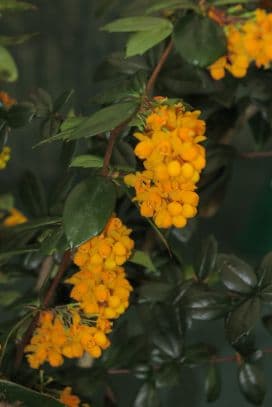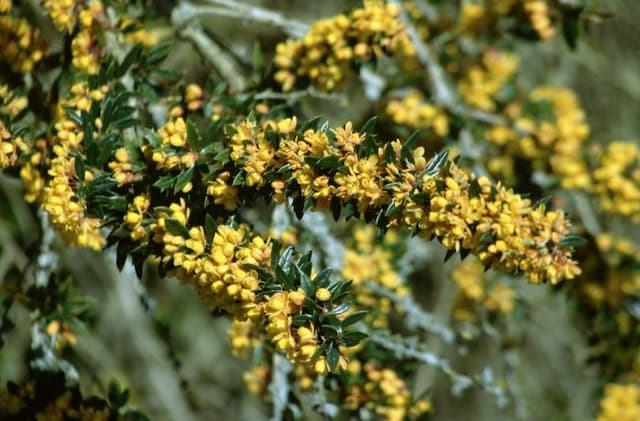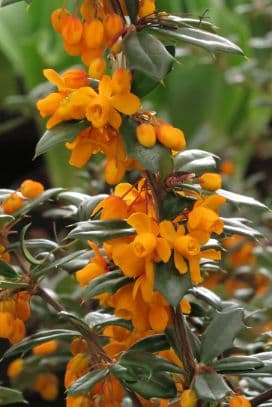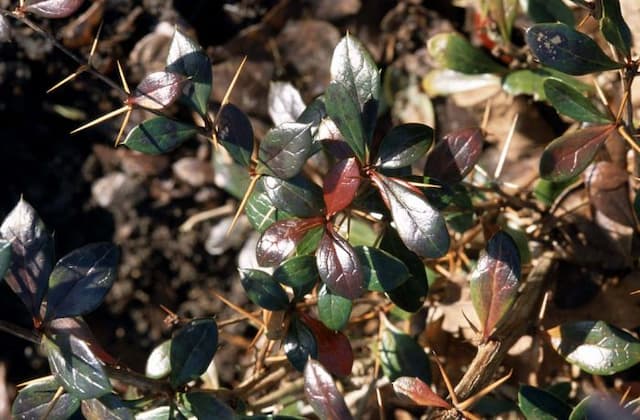Wintergreen barberry Berberis julianae

ABOUT
The plant commonly known as Wintergreen Barberry, is a robust, evergreen shrub. It's characterized by its spiny, leathery leaves which are a deep, glossy green. The foliage typically holds its color throughout the year and might turn to a purple or reddish hue in colder conditions. This plant has a dense, rounded growth habit and is often noted for its sharp, thorny branches which make it an excellent choice for defensive hedges. In spring to early summer, it blooms with small, yellow flowers that are clustered together in hanging clusters. These flowers are quite fragrant and are attractive to various pollinators. Following the blooming period, the plant bears small, oblong blue-black berries that are a sharp contrast against the dark foliage. These fruits can last well into the winter, providing visual interest and a food source for birds. With its formidable thorns, it's also known for providing protective cover for birds and other wildlife. It's a hardy plant that can tolerate a range of conditions, which, coupled with its aesthetic appeal and wildlife benefits, makes it a popular choice for gardens. Despite its beauty, care should be taken when planting it, especially in areas where children or pets may come into contact with its sharp thorns.
About this plant
 Names
NamesFamily
Berberidaceae
Synonyms
Wintergreen Barberry, Chinese Barberry
Common names
Mahonia julianae, Berberis julianae var. laotica, Mahonia neubertii
 Toxicity
ToxicityTo humans
Wintergreen barberry is known to be toxic to humans if ingested. The berries, leaves, and roots contain alkaloids such as berberine which can cause nausea, vomiting, diarrhea, and dizziness if consumed in significant amounts. Ingestion of large quantities can be especially harmful and may lead to more severe health issues, including potential damage to the liver or kidneys. It is recommended to avoid consuming any part of the wintergreen barberry plant.
To pets
Wintergreen barberry can also be toxic to pets, including dogs and cats. Similar to its effects on humans, the berberine and other alkaloids found in the berries, leaves, and roots of the plant can lead to gastrointestinal upset if ingested by pets. Symptoms of poisoning in pets may include vomiting, diarrhea, lethargy, and in severe cases, could also lead to liver or kidney damage. It is advised to keep pets away from the wintergreen barberry to prevent accidental ingestion.
 Characteristics
CharacteristicsLife cycle
Perennials
Foliage type
Evergreen
Color of leaves
Dark green
Flower color
Yellow
Height
5-6 feet [1.5-1.8 meters]
Spread
5 feet [1.5 meters]
Plant type
Shrub
Hardiness zones
6
Native area
China
Benefits
 General Benefits
General Benefits- Landscape Aesthetics: Berberis julianae, commonly known as Wintergreen Barberry, has evergreen foliage that provides year-round visual interest and color in gardens and landscapes.
- Hedge Plant: With its dense and spiny branches, Wintergreen Barberry can be pruned into a formidable hedge, ideal for boundaries or for adding security to a property.
- Wildlife Support: Its berries are a food source for birds and small mammals, while the thorny branches offer protection.
- Drought Tolerance: This plant is quite tolerant of dry conditions once established, making it suitable for water-efficient gardens.
- Shade Tolerance: It can grow in part shade, providing landscaping solutions for areas with limited sunlight.
- Erosion Control: The root system of Wintergreen Barberry can help stabilize slopes and prevent soil erosion.
- Variety in Garden Design: The plant's size and form make it a versatile choice for various garden styles, including formal and informal designs.
 Medical Properties
Medical Properties- Antibacterial: Berberis julianae contains compounds like berberine which have been shown to exert antibacterial effects.
- Anti-inflammatory: The plant may have anti-inflammatory properties potentially beneficial in reducing inflammation.
- Antioxidant: Berberis julianae has antioxidant components that help in neutralizing free radicals in the body.
 Air-purifying Qualities
Air-purifying QualitiesThis plant is not specifically known for air purifying qualities.
 Other Uses
Other Uses- Winter Garden Interest: Berberis julianae, or wintergreen barberry, has persistent fruits and evergreen foliage that add color and texture to winter gardens.
- Security Planting: The thorny nature of wintergreen barberry can be used to create a deterrent hedge against trespassers and animals.
- Soil Erosion Control: Because of its dense root system, it is effective in stabilizing slopes and controlling soil erosion.
- Natural Fencing: Wintergreen barberry can be planted in rows to form a living fence that provides privacy and reduces noise.
- Wildlife Shelter: The dense and thorny habit provides excellent shelter and nesting sites for birds.
- Dye Production: The berries of wintergreen barberry can be used to produce yellow dye.
- Culinary Accents: Although not commonly consumed, the fruits can occasionally be used as an acidulant in culinary practices in some cultures.
- Photography Subject: The vibrant colors and textures of the plant make it a popular subject for photographers, especially in the autumn season.
- Bonsai Creation: Wintergreen barberry is sometimes used for creating bonsai due to its small leaves and the ease of shaping its woody stems.
- Architectural Planting: Its structured growth habit makes it suitable for formal gardens and can be used to accentuate architectural features in the landscape.
Interesting Facts
 Feng Shui
Feng ShuiThe Wintergreen Barberry is not used in Feng Shui practice.
 Zodiac Sign Compitability
Zodiac Sign CompitabilityThe Wintergreen Barberry is not used in astrology practice.
 Plant Symbolism
Plant Symbolism- Protection: Berberis julianae, commonly known as Wintergreen Barberry, has the symbolic meaning of protection due to its thorny branches, which can create a barrier against negative forces.
- Sharpness: Its thorns also represent sharpness and clarity, suggesting that Wintergreen Barberry can symbolize a clear mind or intellect.
- Resilience: This plant is known for its hardiness and ability to withstand challenging conditions, making it a symbol of resilience and endurance.
- Adaptability: Wintergreen Barberry is adaptable to various environments, symbolizing flexibility and the ability to thrive in different situations.
 Water
WaterFor Wintergreen Barberry, it's important to maintain a consistent watering schedule, especially during the first growing season to establish a deep, extensive root system. Water the plant deeply once or twice a week, depending on weather conditions and soil type. Generally, the plant requires about 1 inch of water per week, which translates to approximately 0.6 gallons for a small shrub. During hot, dry spells, increase the frequency of watering but ensure the soil is well-draining to prevent root rot. Reduce watering in the winter when the plant is dormant.
 Light
LightWintergreen Barberry prefers full sun to partial shade. It grows best in a location where it can receive at least 4 to 6 hours of direct sunlight daily. The ideal spot would be one that offers morning sunlight and some afternoon shade, particularly in regions with intense heat, to prevent leaf scorch.
 Temperature
TemperatureWintergreen Barberry is tolerant of a wide range of temperatures but thrives best in regions where the temperature ranges between 40°F to 90°F. It can withstand minimum winter temperatures of down to -20°F. The ideal temperature for robust growth and flowering is between 60°F to 75°F.
 Pruning
PruningPruning is essential for Wintergreen Barberry to maintain its shape and to encourage healthy, dense growth. Prune in late winter or early spring before new growth starts by removing any dead or damaged branches and shaping the plant as desired. It's also beneficial to thin out the shrub every few years to allow light and air to reach the inner branches. The best time for this heavier pruning is late winter, just before the spring growth begins.
 Cleaning
CleaningAs needed
 Soil
SoilWintergreen barberry thrives in well-drained soil with a mixture of loam, sand, and organic matter. The ideal pH for the soil should range between 6.0 and 7.5. A blend of two parts garden soil, one part sand, and one part compost or peat moss can promote healthy growth.
 Repotting
RepottingWintergreen barberry does not require frequent repotting and can be repotted every 2-3 years. It's best to repot in early spring before new growth begins, using fresh soil mix.
 Humidity & Misting
Humidity & MistingWintergreen barberry is adaptable to a wide range of humidity levels, but it does best in average humidity conditions. It is quite tolerant of dry air and does not require any special humidity adjustments.
 Suitable locations
Suitable locationsIndoor
Use well-draining soil, bright light, and keep at moderate temps.
Outdoor
Plant in sun to part shade, well-draining soil, and water regularly.
Hardiness zone
6-9 USDA
 Life cycle
Life cycleThe life of Wintergreen Barberry (Berberis julianae) begins with germination, where seeds, often dispersed by birds, sprout in well-draining soil and partial to full sunlight. The seedlings slowly evolve into young plants with spiny leaves that are evergreen, offering year-round foliage. As the plant matures, it develops into a dense shrub reaching up to 6 feet tall with a similar spread. During spring, mature Wintergreen Barberry produces small yellow flowers, which are pollinated by insects, leading to the development of oblong, blue-black berries by late summer to early autumn. These berries are then eaten by birds and animals, spreading the seeds to new locations. Finally, the plant reaches senescence where growth slows, and it may eventually die, though it can live for many years with proper care.
 Propogation
PropogationPropogation time
Spring to Summer
The most popular method of propagating the Wintergreen Barberry is through semi-hardwood cuttings taken in late summer. To do this, select healthy, non-flowering shoots of the current year's growth. Cut a 4 to 6-inch (about 10 to 15 cm) length from the stem, making sure that each cutting has at least two or three sets of leaves. Dip the cut end into rooting hormone to enhance root development, then plant the cutting into a mix of peat and perlite or sand, which has been pre-moistened. The cutting should be placed in a well-lit area, but out of direct sunlight, and kept at a consistent temperature. It's important to maintain high humidity around the cuttings by covering them with a plastic bag or placing them in a propagator. Roots typically develop within several weeks, after which the cuttings can be transplanted to individual pots to grow on before being planted out the following spring.







![Japanese barberry [Bonanza Gold]](/_next/image?url=https%3A%2F%2Fplants-admin.emdemapps.com%2Fimages%2Fplants%2F%2Fimages%2F604b5385e413f.png&w=640&q=75)

